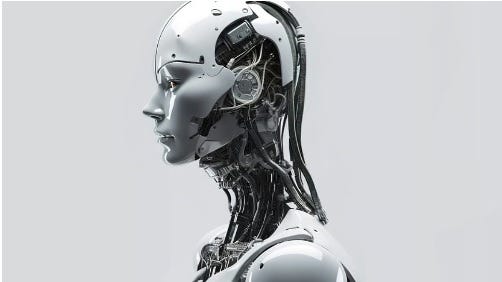They Are Here: The Rise and Rise of AI-Robots
A confluence of catalysts is acclerating investment and adoption of robots. The loss of jobs has serious societal implications. The politics of economics will force a review of the social contract.
They are at airports, hotel lounges, aiding doctors, manning warehouses and factories. Masayoshi Son is making a $1.3-trillion bet, Tesla is launching the Robotaxi, Amazon’s delivery robots will automate $200 billion in logistics costs. A confluence of catalysts is acclerating investment and adoption of robots. This has serious societal implications as livelihoods are disrupted. The politics of economics will force a review of the social contract between people and the state.
Shankkar Aiyar | The Third Eye | The New Indian Express | 22 Jun 2025
Podcast: The Ubiquitous Rise of AI-Robots
You can spot them blinking away, triggering awe and curiosity. They enable check-ins at some airline counters at airports, roll across hotel reception areas offering welcome drinks, serve orders at restaurants. They are manning warehouses, factories and logistics hubs. They are deployed at bars, aid doctors in surgery and first responders to triage. They are not yet ubiquitous, but there is no doubt that robots are here.
The buzz is visible in headlines streaming live. Masayoshi Son is making a $1.3-trillion bet under Project Crystal Land alongside TSMC for building robots and AI hubs. Tesla is all set, finally, to unveil its Robotaxi in Austin, Texas. Nvidia and Foxconn are in talks to deploy humanoid robots at the Houston AI server plant.
Amazon deploys AI-enabled robot Vulcan at its warehouses and plans to deploy delivery robots to automate $200 billion in logistics costs. A Chinese outfit has unveiled the first robotic hand combining tactile perception with complete motion capabilities. Hexagon launched Aeon, a humanoid designed for industry for autonomy, automated measurement systems and perception — and what’s more, it can produce digital twins.
Indian entities, too, are chasing productivity to expand the use of robotics for an array of businesses. Reliance-backed Addverb is launching humanoid robots to eliminate ‘3D jobs’, ones that are dull, dirty and dangerous. Bengaluru-based Invento is developing Mitra robots for retail, hospitality and senior care.
Kochi-based Asimov Robotics develops robots for high-risk settings. Hyderabad-based Svaya Robotics specialises in industrial robots for collaborative tasks in manufacturing and logistics. Bengaluru start-up Genobotics is the developer of Bandicoot robot which automates sewer cleaning. Kody from Ahmedabad is developing robots for surveillance, office services and industry.
The term robot owes its etymology to the Czech word robota, which means forced labour, and was introduced in Czech author Karel Capek’s 1921 science fiction play Rossum’s Universal Robots. Robots made their cinematic debut in 1927 in Metropolis, a movie about a polarised society in a divided futuristic city.
Popular passions, though, surfaced with the 2007 blockbuster Transformers about alien robots produced by toymakers Hasbro and Takara Tomy and Schwarzenegger starrer Terminator. A century after Capek’s coinage, a combination of factors has spurred the creeping robot evolution to a tipping point. The blend of knowledge and technology has propelled investments.
Just in the past 10 days, a stream of start-ups developing robots have raised millions with ease. The Chinese Unitree Robotics, known for its robot dogs and humanoid robots, secured funding at a valuation of $1.4 billion. Pittsburgh-based Gecko Robotics, a start-up specialising in infrastructure inspection, received funding to touch a $1.25-billion valuation.
Slovenian Sunrise Robotics, which builds modular industrial robots, obtained seed funding of $8.5 million. Zurich-based aerial robotics firm Voliro secured $23 million. European Sojo Industries, focused on mobile packaging lines, received $40 million. Coco Robots, a delivery start-up in New York, raised $80 million to scale up sidewalk delivery robots.
A confluence of catalysts — the accelerated evolution of AI, access to powerful chips, fall in the prices, and the need for skills and productivity — are driving expansion. AI algorithms empower robots to analyse data in real time, improve perceptions, and enable responses to dynamic situations and complex tasks amid uncertainty. Machine learning helps robots to pick up patterns and refine actions for efficiency.
A critical factor driving the expansion is scarcity of capacity. The world’s largest economies, particularly Japan, Europe, China and the US, are ageing and immigration is a political hot potato. Worsening this is a scarcity of skilled manpower. A Korn Ferry report estimates the global talent shortage at 85 million unfilled jobs by 2030.
The International Federation of Robotics says robot density (number of robots / 10,000 employees) is up in ageing countries. South Korea has 1,012 robots per 10,000 employees in the electronics and automotive sectors, Singapore has 770, China 470, Germany 429 robots and Japan 419. Global robot density in factories has doubled in seven years and the market is expected to surge from $64.8 billion to $375.82 billion by 2035.
Read all columns by Shankkar Aiyar
The increasing ubiquity of AI-enabled robotics has serious implications for societies, as livelihoods are disrupted by the induction of AI, advent of agentic usage and adoption of robots. Tesla and Foxconn have shrunk their workforce over the years. Corporations including Klarna, UPS, Duolingo, Intuit and Cisco are replacing workers with AI automation. This week, Amazon CEO Andy Jassi revealed that the company will trim its workforce in the coming years.
The adoption of AI robots is not just among ageing populations. India and Mexico have younger populations with median ages under 30. However, in a globalised digital economy, companies will and must adopt technology to compete and deliver efficiency in costs. A World Bank study reveals AI-enabled technology could impact 60 percent of jobs in advanced economies and 40 percent in emerging markets. It is true that technology also creates jobs, but those retrenched may not necessarily be in place or skilled to migrate.
The challenge before societies — particularly in developing economies — is to design programmes for those who can be skilled and craft welfare schemes for those who will be left behind. The politics of economics will force intervention and script a new social contract between the people and the State.
Shankkar Aiyar, political economy analyst, is author of ‘Accidental India’, ‘Aadhaar: A Biometric History of India’s 12-Digit Revolution’ and ‘The Gated Republic –India’s Public Policy Failures and Private Solutions’.
You can email him at shankkar@shankkaraiyar.com and follow him on X / Twitter @ShankkarAiyar. This column was first published here. His previous columns can be found here.




